

|
Back to |
| The Front Page |
| Letters & Opinion |
|
Do women equal men? By Bob Alman with considerable help from John Prince and Greg Bryant |
Our American editor has studied this question, at length--since 1997. Not as an anthropologist, but as a teacher of novices and as an After School Consultant in the middle schools of Palm Beach County. He reports, here, the actual difference--as a generality--in the way the two sexes approach and conduct their play in the game. John Prince and Greg Bryant of New Zealand have added to the mix history, opinion, research, and personal observations. Our editor reports his own travails in proposing separate contests for the two sexes in America. He speculates as to why and how the traditionally separate contests continue and flourish in the commonwealth countries and are endorsed by the World Croquet Federation, although they are virtually forbidden in America. And he asks here--right up front-- WHY AREN'T WOMEN ALLOWED TO COMPETE AGAINST EACH OTHER as men are allowed to do, in separate events? Finally he proposes--well, you'll have to read to the end for that part....
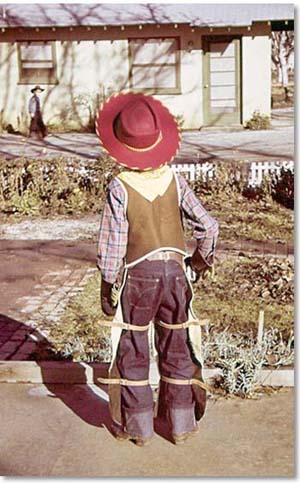
|
| The gunslinger in the foreground prepares to defend his domain. Photo by Joseph Cowles. |
Observing full-grown adults of the species is not necessary. If you go to the Middle Schools of Palm Beach County, you can see very, very clearly, indeed, the difference between boys and girls--the primates who, for the most part, will survive to adulthood despite their dangerous and illogical behavior as 11-year-olds.
Put the boys and girls together in a game of SuperSize croquet and observe what happens when a doubles team of boys takes on a doubles team of girls in Golf Croquet. The girls quickly and (I will maintain) instinctively operate as a team. Whether they understand the concept or grasp its significance, in practice, in the game, they are functionally a team because they deliberate on what is to be done at critical points, they come to an agreement, and then they do it.
From a distance of, say, 20 feet from the hoop, the girls will decide to approach to position when (for example) the nearest position an 11-year-old boy has is 30-or-so feet from the jaws. But the boys--without consulting each other--will shoot for the hoop, nearly every time, from an unrealistically long position. (YES, sometimes they will score; usually, they will miss and overshoot.)
The boys have little concept of "team," they only want to score, and here's the important part: THEY BELIEVE THEY CAN MAKE THE SHOT, EVERY TIME, AND WILL NOT BE CONVINCED OTHERWISE, EVEN AFTER MANY FAILURES.
The girls, on the other hand, behave as if focused on winning the game as a cooperative team, and enjoying being together.
I have watched this scenario play out countless times in my three years as an After School Consultant with the public schools of Palm Beach County. Any competent anthropologist might observe, with me, the utter consternation of the boys when the girls win the game. It's more than bad luck: it's as if the order of the universe has changed. It's unjust! It's actually unfair--because the boys know they're really good at this game.
With no anthropology credentials whatever, I say the 11-year-old boy is a born hunter and the 11-year-old girl is an instinctive nurturer and communicator, and they reveal those "natural" roles in their play of croquet. This dynamic has been seen in croquet from the beginning. In fact, in the garden parties of England in the 1850's, it was the social aspect of croquet that made it an ideal flirting ground for men and women.

|
| In earlier centuries, "innocence" was portrayed in lighter skin tones. In this painting, the most innocent and pure figures (albeit frolicking with naked men and doing god-knows-what) are very, very white. |
Winning the game of croquet was not important for the players or the host; it was not even the goal of the event. What mattered is whether you scored a future engagement with the attractive and flirty opponent or partner. For the hosts, croquet was an ideal way to take care of eight people (or more, if more than one croquet set was on hand.)
Packaging and selling a recipe for seduction
More than 160 years ago, that's what the shrewd John Jaques did for the hosts of those garden parties of 19th Century England and for their guests. At last the hosts could organize an activity that would bring the the sexes together, and mix well with beverages and cucumber sandwiches. They could flirt at leisure in the garden, over croquet--with no time limit.
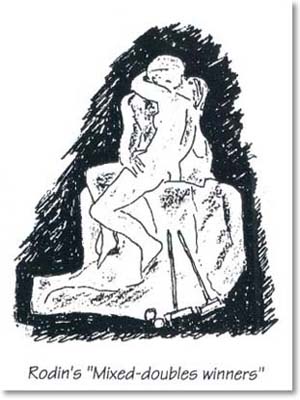
|
| In real life and real croquet, the partnership affinity Jack Shotton celebrates in David Appleton's "Lighter Side of Crqouet" is rarely if ever achieved. |
As the "pastime" gradually morphed into an organized sport, the character of the game changed, along with the core membership of national organizations, over time. In Australia, croquet was for a time almost the exclusive province of women--an opportunity for them to get out of the house. The bowling game on the adjacent lawn might very well have been exclusively male. New Zealand had a similar pattern of development.
Famously, England alone had a huge proportion of male players in the second half of the 20th Century, deadly serious and dedicated to constant improvement--and the social aspect of the game was neglected until Egypt came into the world federation with Golf Croquet and made it respectable throughout the world.
In every country except the US--including Egypt-- there are separate competitions for men and women. And in every country of the world except the USA, high-level, ranked "mixed doubles" are regularly played. Why is the US alone in this, as in so many other things, in the 21st Century?
Has "political correctness" so inserted itself into social mores that certain things must not be done because of the way things were in Victorian England 150 years ago? Are we not mature enough, finally, and brave enough to organize games for any group we choose--for the sport of it, for the fun of it--without being damned as sexist?
I ask again, respectfully: Why are the women of American denied the pleasure of competing against each other in sanctioned USCA events? And why can't they compete with males as partners in an event designed and programed for "mixed doubles?"
Look at what happens on your club courts
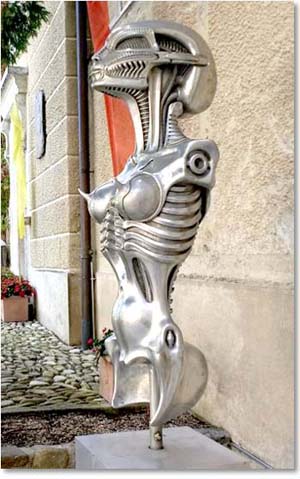
|
| The female of the species as THE ALIEN, ferocious in protecting her offspring, often puzzles her male partner with unreasonable restraint on the croquet court. |
The only change you need to make in this naturally-occurring happenstance is to formalize the experience as a sanctioned tournament called the "Women's Open." And then, you might also organize a competitive event called the "Mixed Doubles Championship" exclusively for male/female competitive teams. If you're brave enough to make this happen at club level, you might expand it to the regional level, and thus prove to your national organization that these formats are wanted and needed.
I hasten to comment that it's not the USCA's fault that such events are not played regularly. Based on my own experience, I'd say it's the fault of the women, themselves, who say that separate events are "stigmatizing" and that "mixed doubles" would likely only pair a strong man with a pliant and relatively weak woman. Really?
To figure out how the Americans continue in this self-defeating folly, I decided to research gender separations and mixed doubles in other countries--the countries where the sport of croquet came to full flower at the beginning of the 20th Century. I started in New Zealand.
Boys and girls differ just as men and women do
As the official Sports Development Officer of Croquet New Zealand, Greg Bryant decided that a bigger investment in local clubs would have the greatest long-term positive impact on the overall health of the sport. When he took on the job of recruiting and training secondary school students in 2014, he was prepared to wait for a pay-off that might not be seen until a Shield contest in the 2020's. As it turned out, he didn't have to wait nearly that long. By the middle of 2018, his teen players--of both genders had already achieved impressive titles in national and world events.
They include WCF U21 gold, silver & bronze medals for Josh Freeth, Felix Webby, and George Coulter; WCF Golf Croquet Worlds bronze bronze for Webby, World Association Croquet team selections for Edmund Fordyce and Webby; Trans-Tasman AC team selection for Freeth, New Zealand Open Golf Croquet Championship for Fordyce; numerous Island Championship titles, mostly in Golf Croquet, and the New Zealand Women's Golf Croquet Championship for Grace Mohi and Ellie Ross). And with senior partners. Fordyce and Webby won medals in the New Zealand's Association Croquet Doubles Championship.
However, Bryant has noticed as a coach that the gender differences between men are women are reflected in the way boys and girls learn and in their different results in competition, and he has incorporated that knowledge in the way he coaches, which he details at the end of this article.

|
| The gender-bending male figure here appears less delighted than the ecstatic female waiting knife-in-hand to devour the prize. Photo courtesy of Barb and Joseph Cowles. |
The legendary John Prince, who still competes in croquet, has kindly produced observations and statistics from New Zealand that both confirm the generalities of the difference in performance and deny it by pointing to the exceptions.
The lessons of Kiwi history
Early in the sport's development, according to croquet historian D.M.C. Prichard, Championship Doubles in England were presumed to mean Mixed Doubles. That was not the case in New Zealand, according to Prince, who writes, "Two years after the championship doubles started, two men playing together won the title in 1915 and then two women in 1926. Overall, women have won the doubles as a pairing seven times. However, mixed pairings did seem very popular as up until 1971 a mixed pair took the title 33 times.
"But after 1971, we had to wait until 2005 for another mixed pair to take the title--Bruce and Liz Fleming from Australia did that, and then Jenny and Chris Clarke won it in 2007, 2014 and 2015. So in recent years, it has been mostly male combinations who emerged as winners. I imagine the restriction that "two men may not play together" applied to doubles at a local level as more men started to play, but that is no longer the case.
"However, the gender restriction nearly did happen once when in the mid 1950's," Prince recalls, "at the New Zealand Championships, Arthur Ross and Ashley Heenan entered the doubles as a team, and because they were two of the leading players of the day some thought the pairing unfair and planned to put a proposal to the "player's meeting" held during the Championship that would have prevented two men entering future doubles championships as a partnership, a restriction already applied to many other tournaments.
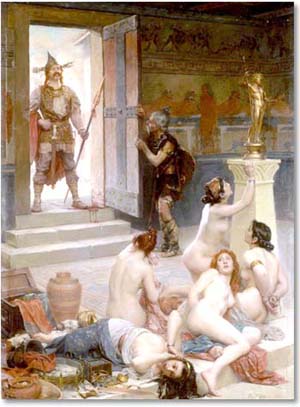
|
| One can help wondering: Which trophy will the warrior choose? |
As for the New Zealand Open Championship, Prince reports, "Only five women have won it, including Rene Watkins who did so four times, but many others were formidable opponents: the runner up in the Open has been a woman 22 times, the last ones being Susan Wiggins in 1983 and Jenny Clarke in 2014.
"Early MacRobertson Shield teams comprised both men and women, but after 1969 Jenny has been the only one, playing in 2010, 2014, and 2017. She was team captain in the latter and in doing so became the only woman to captain a New Zealand MacRob team.
According to Prince, "The New Zealand Men's and Women's and Mixed Doubles Championships continue to be played most seasons but perhaps the quality of the fields in the singles--especially the Men's--is not as strong as it was when the event was played as part of the Open Championship. However, I am delighted to report that Liz McLay and I are the current holders of the New Zealand Mixed Doubles Championship."
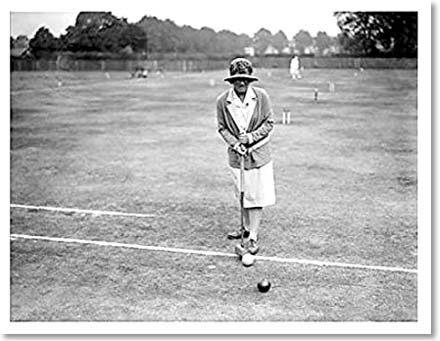
|
| The formidable Miss D.D. Steel on the court in her prime prepares to rush. Her stance was unusual, albeit spectacularly successful in the twenties and thirties. |
Meanwhile, England has been more careful about gender-mixing
According to Prichard, early in the 20th Century, "Gold Medals were altered from Open and Women's to Men's and Women's but owing to an ambiguity in the wording of the conditions it appeared that women could still enter for the men's event. This Miss [Lily] Gower did and won it, a feat that Miss Nina Coote repeated the next year. Women had won the Open Championship and Men's Gold Medal five times in the last eight years and the men had had enough. In 1909 the committee passed an unequivocal resolution 'the women could not enter for the Men's Gold Medal nor men for the Women's."
The President's Cup was started in the 30's as an invitational for Britain's top eight, so there was no gender restriction in it. A youthful Debbie Cornelius was delighted to take her rightful place in it, some 20 years ago. No other woman has done it since Debbie's achievement in 1996.
Meanwhile, in the traditionally very strong British Opens, with an international field (before the advent of the World Croquet Federation, it was the de facto "world championship") I noted that three women entered the qualifying Swiss that precedes knockout event of 2018.
Why can't a woman be more like a man?
She can be, as it turns out, and not just in Shaw's Pygmalion. But while croquet attracts mostly male nerds (as Richard Hilditch has suggested) who actually admire the solitary 25-minute displays they regard as expert play (which women may tend to regard as tedium) it's no wonder that the female of the species wants to devote her thinking to more interesting enterprises.
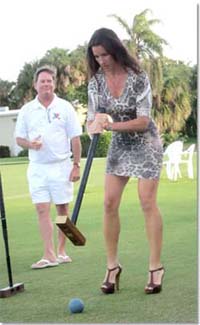
|
| In this clearly unequal contest, it's not possible to determine who suffers the most consequential handicap. Snapped at a corporate event at the National Croquet Center. |
I usually counsel the couples in novice training to avoid partnering each other when they join the club--because, I tell them as part of my standard schtick, "When you have a huge argument over the strategy that causes your acrimonious divorce, one of you will get the dog and the other the croquet club membership..." The truth is that the difference in style and attitude are usually evident in the novice games. I recommend strongly and seriously against "spousal croquet" but also don't try to pit men against women.
I hasten to point out that there are SPECTACULAR exceptions at novice level, which I am always delighted to point out. I have taught classes two classes this year in which I could honestly tell a female player, "You are in the top two percent of novices I teach on Saturday." They are usually women who play other sports competitively. But here, again, it's dangerous to generalize.
What is wrong with America?
(Yes, of course you're right, but I mean in ADDITION to that.) Although there are "mixed doubles" contests in many parts of the world, any such proposal is instantly aborted on political grounds in the United States. In San Francisco in the 90's, my "Women's Championship Open" was boycotted by all but two women--club members Margaret Chatham and Wanda Lee Smith. Only four people were present: the competitors, Hood Chatham, and myself. We did the event as a best-of-three (which Margaret won), awarded the trophy, and drank the champagne. I widely reported the results. No such event has been tried again, by anyone, to my knowledge.

|
| The author explains the backstory of this R. Neubert painting of Bob Alman in a wedding dress. |
While there is still a Men's and Womens' Championship in England for Association Croquet, the practice did not immediately carry over to the World Croquet Federation. However, the admission of Egypt into the WCF allowed traditions to be re-invented in step with both the times and Egyptian tradition (which also inspired the "under 21" championships.) There are now regular open world championships in both codes, and world womens championships for both Association Croquet and Golf Croquet.
It turns out that women CAN be just as competitive as men, in the office as well as on the croquet court. So I have to ask once more as strongly as I possibly can: What is wrong with America? Why must we continue to deny women the pleasure--and the sport!--of competing against each other in formal tournaments?
Wouldn't American women benefit by joining the rest of the world and enjoying competing against each other for titles and trophies--not just in pickup games on the club courts? Will they insist on having their daughters grow up with chips on their shoulder because of attitudes on protecting the rights of women that seem quite dated in the western world of 2018?
Mixed doubles is a special joy when you have a man and a woman as partners in a competitive game. Of course there are such mixed partnership in sanctioned "open" play, but why aren't there competitions and awards and trophies and titles for mixed doubles as regular events--at club level, in the regionals, and at the national championship level as well? Compromising the killer instincts of the guy with the instinctive nurturing impulses of the girl can be enlivening--even in a game of a croquet.
Why is America so resolutely backward in this respect? Couldn't the Americans emulate the other croquet countries in this regard, finally: for the pleasure of the competition, and for the sport of it?
Here's my final word on this issue: Men and women are unequal in physical and mental aptitudes and totally equal in their human rights. Croquet is a famously egalitarian sport. Could not our sanctioned events and championships be organized to celebrate both our gender differences and our equal rights?
|
COACHING BOYS AND GIRLS Learning differences of males and females is a topic of considerable interest in my role of promoting youth participation in a sport that proclaims gender equality. It is clear that there are performance differences between men and women, as well as learning differences. Thanks to a reasonable handicapping system, we can still purport to be a non gender specific sport but it is a fact that very few females appear in the top level of open competition. Historically, the development of the sport has been similar in New Zealand and Australia. It's said that a hundred years ago the ladies were not permitted on the bowling lawn, but were an important contributor to the catering needs of their bowling husbands during the day. It might be a convenient rumour that croquet was provided next door for the ladies to that end but nonetheless, croquet initially included a significantly higher number of women than men. The customary hedge surrounding the ladies' croquet was presumably planted to screen the uninvited gaze of the all-male bowling fraternity! Of course in our efforts to promote the sport, we are taking down the hedge surrounds, but many croquet clubs will still be found adjacent to bowling clubs. As the records show, trends changed up to and since the mid 1900's when the overwhelming dominance of male players in open events and international team selections increased. A very small number of extremely talented and ambitious competitors are women. Personally, I'm not particularly concerned about gender differences in open competition. The sport offers more than enough for anyone to aspire to and achieve without being too concerned about open competition results. As to the distinctions in the learning process of males and females, I can only observe that as a generality, the boys want competition, quickly. (Immediately isn't soon enough!) The girls on the other hand want to do stuff with their friends. They all--both the boys and girls--appreciate inclusion and recognition, and expect their coaches to guide them towards consistency. I find that accommodating the learning and physical differences of boys and girls in a combined coaching session is most effective if the fundamentals of 'player centred' coaching styles are followed, that is; understanding the players' perspectives and collaboratively working out a solution. Getting to know each individual in an introductory school group session of boys and girls is not practical, but careful planning of the activities within a coaching session can accommodate most individual needs. Look for the common factors and accommodate them. For example: Girls like doing stuff with their friends and they enjoy working things out together. Boys want to compete immediately, preferably against other boys. In introductory sessions, with everything in pairs, girls should be paired with girls, boys with boys. Accommodate obvious or alternative pairings only if it suits the group. After introductions and briefing, the first activity should be a game of some sort. How we respond during coaching opportunities within the game and in follow-up is critical. You might ask questions about what players are trying to achieve and what they're trying to do to achieve it, for example. Girls will be predominantly looking for approval that they're holding the mallet properly, or swinging straight. Boys will tend to think they're as good as their best shot, or describe their opponent's unfair advantages. In each case, there will be a coaching opportunity suited to the player. Then place an emphasis on the player's individual goals within the game/exercise. Whenever possible, seek further feedback from the players. And repeat, repeat, repeat. It seems a fairly simple or even dated approach, but I find it works best for the quality of experience of the group. By accommodating the instinctive traits of boys and girls initially, they are given the space and time to exhibit their individuality, their small personal goals. Suitable feedback will provide some validation and confidence. And it's all so more effective and less time consuming when the pairs are the same gender! The key difference I've made in my coaching style is simple. I now try to avoid single, common goal outcomes or a predetermined plan of group progress, other than my own values for the session as a coach--which will certain accommodate fun and inclusion. I now allow a lot more time in group coaching sessions to interact more directly with individuals, making sure at the same time that everyone is occupied. I try to identify their individual goals collaboratively, be it for the next shot or qualifying for the next world championship. As it happens, I've just booked a place at a School Sports Council conference in September addressing gender needs in school sport. I hope to become a better coach by listening to the shared experiences of other coaches in many sports, both male and female.
- Greg Bryant, |